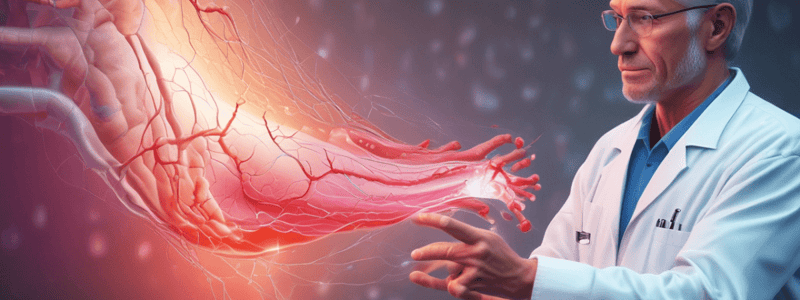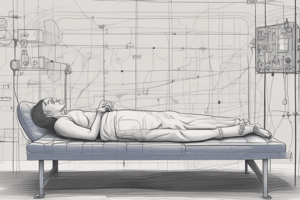Podcast
Questions and Answers
What is the primary mechanism of action for non-depolarizing neuromuscular blockers?
What is the primary mechanism of action for non-depolarizing neuromuscular blockers?
- Interference with calcium release from the sarcoplasmic reticulum
- Activation of nicotinic acetylcholine receptors leading to depolarization
- Inhibition of acetylcholinesterase
- Competitive antagonism of acetylcholine binding to nicotinic acetylcholine receptors (correct)
What is the typical effect of succinylcholine on train-of-four monitoring?
What is the typical effect of succinylcholine on train-of-four monitoring?
- No fade and no post-tetanic facilitation (correct)
- Fade in the train-of-four response
- Post-tetanic facilitation
- Increased train-of-four ratio
What is the primary mechanism by which an increase in immature forms of nicotinic acetylcholine receptors can lead to complications with neuromuscular blockers?
What is the primary mechanism by which an increase in immature forms of nicotinic acetylcholine receptors can lead to complications with neuromuscular blockers?
- Decreased sensitivity to both depolarizing and non-depolarizing neuromuscular blockers
- Altered metabolism of neuromuscular blockers
- Increased sensitivity to succinylcholine leading to excessive potassium release (correct)
- Increased sensitivity to non-depolarizing neuromuscular blockers
Which of the following is a key difference between succinylcholine and non-depolarizing neuromuscular blockers? (two answers)
Which of the following is a key difference between succinylcholine and non-depolarizing neuromuscular blockers? (two answers)
What is the primary reason that routine use of succinylcholine in healthy children is now considered contraindicated?
What is the primary reason that routine use of succinylcholine in healthy children is now considered contraindicated?
What is the primary mechanism by which non-depolarizing neuromuscular blockers produce their effects?
What is the primary mechanism by which non-depolarizing neuromuscular blockers produce their effects?
According to the 2023 ASA Practice Guidelines, what is the recommended neuromuscular monitoring site?
According to the 2023 ASA Practice Guidelines, what is the recommended neuromuscular monitoring site?
What train-of-four ratio is recommended for extubation?
What train-of-four ratio is recommended for extubation?
Which reversal agent is recommended for deep, moderate, or shallow neuromuscular blockade induced by rocuronium or vecuronium?
Which reversal agent is recommended for deep, moderate, or shallow neuromuscular blockade induced by rocuronium or vecuronium?
What action is recommended for patients with adequate spontaneous recovery to a train-of-four ratio ≥ 0.9?
What action is recommended for patients with adequate spontaneous recovery to a train-of-four ratio ≥ 0.9?
According to the guidelines, what is the primary objective of monitoring and antagonizing neuromuscular blockade?
According to the guidelines, what is the primary objective of monitoring and antagonizing neuromuscular blockade?
What is the general rule regarding decreased potency of neuromuscular blockers?
What is the general rule regarding decreased potency of neuromuscular blockers?
How do volatile anesthetics affect the potency of neuromuscular blockers?
How do volatile anesthetics affect the potency of neuromuscular blockers?
What is the primary issue with clinical assessment of recovery from neuromuscular blockade?
What is the primary issue with clinical assessment of recovery from neuromuscular blockade?
What is the issue with using a nerve stimulator without objective measurement?
What is the issue with using a nerve stimulator without objective measurement?
How do different muscles respond to neuromuscular blockade?
How do different muscles respond to neuromuscular blockade?
How do anticholinesterases work to reverse neuromuscular blockade?
How do anticholinesterases work to reverse neuromuscular blockade?
What is the primary objective when monitoring the Train of Four ratio?
What is the primary objective when monitoring the Train of Four ratio?
Which muscle is most commonly stimulated during electromyography to measure the action potential?
Which muscle is most commonly stimulated during electromyography to measure the action potential?
What does a deep neuromuscular block mean in clinical terms?
What does a deep neuromuscular block mean in clinical terms?
Which placement is correct for the negative electrode during stimulation of the adductor pollicis muscle?
Which placement is correct for the negative electrode during stimulation of the adductor pollicis muscle?
When is reversal unnecessary after monitoring a Train of Four ratio?
When is reversal unnecessary after monitoring a Train of Four ratio?
What muscle demonstrates delayed recovery relative to diaphragm and laryngeal muscles due to greater sensitivity in neuromuscular monitoring?
What muscle demonstrates delayed recovery relative to diaphragm and laryngeal muscles due to greater sensitivity in neuromuscular monitoring?
What defines an intense neuromuscular block in monitoring criteria?
What defines an intense neuromuscular block in monitoring criteria?
Which muscle placement is appropriate for the stimulation of flexor hallucis brevis during neuromuscular monitoring?
Which muscle placement is appropriate for the stimulation of flexor hallucis brevis during neuromuscular monitoring?
Which of the following is a side effect of succinylcholine that is typically preventable with antimuscarinic pretreatment?
Which of the following is a side effect of succinylcholine that is typically preventable with antimuscarinic pretreatment?
What is the most common variant of atypical butyrylcholinesterase, and how does it affect the duration of succinylcholine block?
What is the most common variant of atypical butyrylcholinesterase, and how does it affect the duration of succinylcholine block?
Which of the following is a risk factor for the development of succinylcholine-induced myalgias?
Which of the following is a risk factor for the development of succinylcholine-induced myalgias?
What is the primary mechanism by which succinylcholine can cause ventricular dysrhythmias?
What is the primary mechanism by which succinylcholine can cause ventricular dysrhythmias?
Which of the following is a contraindication to the use of succinylcholine?
Which of the following is a contraindication to the use of succinylcholine?
What is the typical increase in serum potassium level following succinylcholine administration?
What is the typical increase in serum potassium level following succinylcholine administration?
Which of the following is an early warning sign of malignant hyperthermia associated with succinylcholine administration?
Which of the following is an early warning sign of malignant hyperthermia associated with succinylcholine administration?
What is the recommended management for a patient who develops masseter spasm following succinylcholine administration?
What is the recommended management for a patient who develops masseter spasm following succinylcholine administration?
Which of the following is a side effect of succinylcholine that is not typically associated with an increased risk of complications?
Which of the following is a side effect of succinylcholine that is not typically associated with an increased risk of complications?




